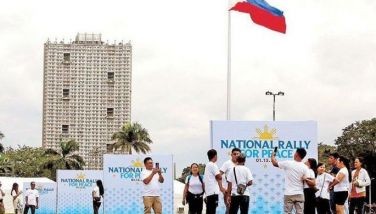Retrogression

Those who have seen Heneral Luna, the movie about Army Gen. Antonio Luna, would have noticed one particular mode of mass transportation during the revolutionary period: trains.
The central terminal in Luna’s time was Tutuban in Divisoria, Manila. The commercial railway service, whose first tracks were laid in 1891, had two lines spanning a total of nearly 1,000 kilometers – one going north up to San Fernando in La Union, and the second to the south up to Legazpi City in Bicol.
World War II destroyed much of the railway system. It was rebuilt post-war but, like many aspects of life in these islands, the service slowly descended into disrepair while other countries in the region moved to modernize their railway systems.
Despite wartime devastation, despite post-war social upheavals including civil wars and struggles for independence from colonial rule, and despite lying within the earthquake-prone Pacific Ring of Fire, our neighbors built modern railway networks.
Today, trains provide rapid, efficient, comfortable and affordable mass transportation in many Asian countries. They have high-speed bullet trains that can travel as fast as airplanes, magnetic levitation shuttles from airports to city centers, subways that run even through underwater tunnels, and rapid transit commuter railways. Taiwan has special railways for industrial use and tourism (old railways once used for forestry and sugarcane production) and continues to expand its train service.
In our case, we are just starting to revitalize our commuter railway within Metro Manila, and not a single line of track has been built in the Northrail project that has been derailed by a corruption scandal.
Now called the North-South Commuter Railway, the first phase of the project aims to provide a train service between Tutuban and Malolos, Bulacan – a stretch of 36.7 kilometers. Malolos is about 237 kilometers from San Fernando, La Union – the southernmost terminal of the Spanish-era railway service. If General Luna were alive, he’d probably blurt out a profanity over this sorry state of our railway system.
* * *
Technocrats have talked to death about the usefulness of a modern railway service for passengers and cargo in Luzon. It can decongest Metro Manila traffic and stimulate economic activity in the service areas.
Yet here we are, unable to break ground for a railway service spanning less than 40 kilometers. Financing for Northrail has shifted from the original soft loan that would have been provided by China’s Export-Import Bank to the Japanese government, which has promised a $2-billion yen loan package for the project.
A government sensitive to the public pulse, led by officials who do not belong to the old rich, would realize the importance of an efficient railway service to the masses. Look at the commuter train service at any hour and see how packed it is. Around the morning and evening rush hours, the trains remind you of what “packed like sardines” means.
Commuters endure the discomfort of the packed trains because they bypass Manila’s infernal traffic, they follow set schedules and the fares are affordable.
Traveling by rail to avoid traffic is popular enough that enterprising individuals have revived the handcar – a cart on wheels that can run on rails, pushed along by the operators or equipped with cranks. When a train approaches, passengers get off and the operators simply carry the handcar out of the way.
Handcars were also popular during General Luna’s time. They were used in the sugarcane fields of Luzon and for commuting within short distances.
Even handcars have been modernized, with engineers in other countries offering self-propelled models with combustion or electric-powered engines. The handcars are used in mines or even for sport. But we can’t even modernize our main railway service so it’s doubtful that there would be any official interest in upgrading this rudimentary railway facility.
Other countries have also preserved their train stations, particularly the main terminals, as historical sites. In Manhattan and Washington, the central stations are top tourist destinations and commercial areas. So are Moscow’s subway stations.
Our main station in Tutuban has a rich history and should be restored as a tourist site. The Paco Railway Station in front of Plaza Dilao in Manila, built by the Americans in 1915, should have been restored. But it was partly demolished in 1996 to make way for (what else) a shopping mall and then was abandoned.
* * *
Then there’s our light railway system. Look at those long lines of people waiting patiently for a ride in the Metro Rail Transit and Light Railway Transit. The service is being run to the ground by the Liberal Party cabal in the Department of Transportation and Communications. Filipinos badly need an efficient LRT and MRT, and commuters don’t deserve this glitch-prone, grossly inadequate railway service.
Commuters want transportation that can travel rapidly around Metro Manila and neighboring areas, unimpeded by traffic, stopping and departing on time and offering rides at reasonable fares.
Trains are the only modes of land transportation that offer all these things. If the government wants to encourage car owners to leave their vehicles at home and use mass transportation, expanding and modernizing the railway services would be one of the best incentives.
Unfortunately for us, our mass transport system is bucking the regional tide and is in retrograde.
- Latest
- Trending




























